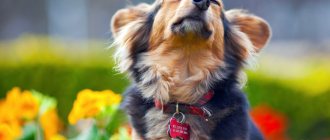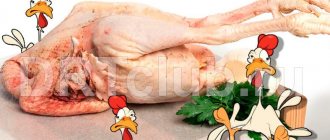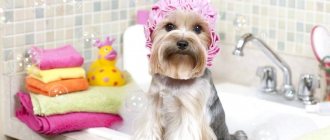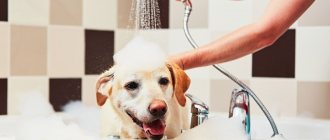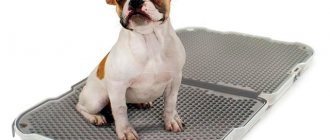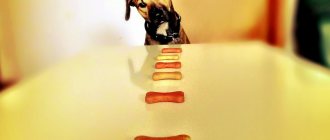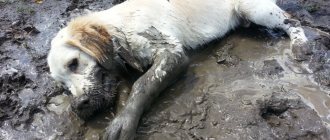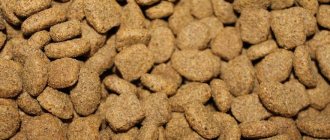The dog is an omniphore (omnivore). Depending on the breed, dogs weigh from 2 (miniature and toy breeds) to 75 kg (Irish Wolfhound, Bernese Mountain Dog). The most important sense organ is the nose (smell), then hearing. Dogs do not see as many colors as humans, but their vision at dusk is excellent. Dogs do not sweat; they only have a few sweat glands on their paw pads, which are unlikely to take part in thermoregulation. Dogs lose heat through panting, so a narrow mouth can cause problems in high ambient temperatures. The stomach of dogs is adapted to receiving gigantic doses of food. If necessary, it can stretch to the pelvic joint - the symphysis.
Depending on the breed, dogs differ significantly from each other in size, character, mobility and service qualities. Before purchasing, you should find out exactly what requirements the animal must meet.
Veterinarian tips for caring for dogs: keeping your pet indoors
Veterinarian tips for caring for dogs:
- When you get a dog, you must first determine where it will live, in the house or in the yard? It is necessary to arrange a good place for the dog in the house, taking into account its size. You need to choose a place where your animal can rest and watch what is happening around.
- Basically, such a place is chosen in the hallway so that the dog can perform a protective function - to protect a person’s house. There is no need to choose a place for it in the kitchen or in someone's bedroom; soon the dog will begin to climb on the table and move onto your bed or your child's bed.
- You should also not place your dog near heating appliances, as this will negatively affect the animal’s fur and body temperature. Once you have chosen the ideal place to place your dog, you need to arrange it.
- For large dogs, a mattress is laid out, and if the dog is miniature, then it is equipped with a basket or a lounger. If the dog is a dwarf breed and you do not walk it outside, then you need to organize a place for the toilet.
- You need to put a special plastic tray and fill it with filler designed to absorb odor. All this is sold in pet stores. A dog that lives in a house also needs a place where it will eat.
- It should be in the kitchen and not have any obstacles so that the dog can freely go and eat. You need to put two deep bowls, made of high-quality material, preferably metal. They wash well and do not absorb the smell of food. One bowl for food, the other bowl for water.
A responsible owner means a healthy dog.
How to properly feed your dog natural food
For your pet's health, it is important to monitor the frequency of feedings and the volume of portions. Eating too rarely is fraught with gastrointestinal disorders, and eating too often can lead to weight gain.
To calculate individual norms, you can use the table below. With its help, you can easily select a weekly menu based on the characteristics of your pet.
Feeding mode
Adult animals over 1 year old are fed twice a day: morning and evening. During free hours, the stomach has time to digest all the food received, which eliminates the feeling of heaviness. A longer break is not recommended, as the dog will begin to experience an acute feeling of hunger. During a therapeutic diet, the frequency of feedings is increased in favor of reducing the volume of single servings.
Puppies are fed much more often:
- 6-8 times up to 2 months;
- 5-6 times from 2 to 3 months;
- 3-4 times from 3 to 6 months;
- 3 times from 6 to 12 months.
The daily portion is divided into the required number of doses in equal or unequal proportions. Here it is better to build on the preferences of your pet. After a night's sleep, many people like to eat a hearty meal, so the morning portion can be made a little larger.
Giving food right before a walk is not recommended. Due to the heaviness, it will be uncomfortable for the pet to move and exercise. And disobedient dogs that tend to run away will be kept from doing so by the feeling of hunger. It is safer to take an hour break after eating or to feed the dog immediately after returning from the street.
Serving Size Calculation
In addition to health status, portion size is affected by age and weight. Puppies need to eat 6-7% of their body weight, and adult dogs - 3-5%. Regarding calories, veterinarians recommend taking into account either age (for puppies) or breed (for adult animals):
- 220 kcal per 1 kg up to 2 months, 265 kcal – from 2 to 3 months, 201 kcal – from 3 to 4 months, 136 kcal – from 4 to 8 months, 100 kcal – from 8 to 12 months;
- 53 kcal per 1 kg for giant breeds, 60 kcal for large breeds, 69 kcal for medium-sized ones, 84 kcal for small breeds, 110 kcal for dwarf breeds.
EXAMPLE: Based on average indicators, you can calculate the norms for a husky - a six-month-old puppy weighing 15 kg and an adult dog weighing 25 kg.
| Age | Weight, kg) | Meat (55%) | Fermented milk products (30%) | Cereals (10%) | Fruits and vegetables (5%) | Total caloric content of daily portion |
| Puppy | 15 | 1122 kcal | 612 kcal | 204 kcal | 102 kcal | 2040 kcal |
| Adult animal | 25 | 949 kcal | 517 kcal | 173 kcal | 86 kcal | 1725 kcal |
Thanks to simple formulas, you can easily calculate the indicator for your pet in calories or grams. Please note that the totals are for general guidance only and are subject to change at the discretion of your veterinarian. Depending on existing problems or lifestyle, your pet may be able to reduce or increase calories, as well as change the ratio of fats, proteins and carbohydrates.
Sample menu for the week
Feeding dogs natural food with a pre-selected menu makes choosing food and preparing meals easier. You can take ideas for breakfast and dinner from the table.
| Day of the week | Breakfast | Dinner |
| Monday | Beef stew with pumpkin and carrots | Minced chicken with rice |
| Tuesday | Beef heart with rice and zucchini | Oatmeal seasoned with fermented baked milk |
| Wednesday | Boiled perch with raw cabbage and potatoes | Cottage cheese with dried apricots |
| Thursday | Chicken meatballs with buckwheat porridge and boiled beets | Ryazhenka with fresh carrot and cabbage salad dressed with linseed oil |
| Friday | Rabbit meat with rice and tomatoes | Meat broth with turkey meatballs |
| Saturday | Buckwheat with boiled pollock, seasoned with olive oil | Oatmeal seasoned with fermented baked milk or kefir |
| Sunday | Tripe with rice and stewed pumpkin | Boiled liver with stewed cabbage |
Despite the possible variety, try to keep the diet as simple as possible. Otherwise, the pet will begin to be picky. The chosen menu can be followed throughout your life.
Also try not to introduce new dishes on the same day of the week. This will help track down the source of allergies or digestive problems if such are suspected.
Veterinarian tips for caring for dogs: keeping your pet outdoors
Veterinarian tips for caring for dogs:
- If the dog will live in the yard, then you need to create all the necessary conditions for it. First you need to determine what material the booth will be built from, where to install it and what size it should be.
- Basically, wood is chosen for the construction of a booth; it is the most heat-insulating material. You need to take good care of the booth, treat the cracks in it so that various parasites, such as fleas or ticks, do not appear there.
- You need to build a booth in accordance with the size of the dog, so he can warm it with his breath during the cold season. The booth is usually installed in a quiet place under a tree with dense foliage, so that in hot weather it shelters the dog from the scorching sun, and in winter from the cold wind. The entrance is made from the windless side.
- By winter, a caring owner should insulate the booth for his pet. They mainly insulate with polystyrene foam and cover it with a sheet of plywood so that the dog does not chew the foam. Veterinarians advise not to place the kennel directly on the ground, but to place it on bricks and lay straw there for the winter, so the floor in the kennel will not freeze.
- If you do everything correctly, then even in severe frost there will be a positive temperature in your dog’s kennel. If you don't want your dog to live on a leash, you can fence off an area for him.
Behavior problems
Doesn't want to be alone. Howls, makes trouble
A dog, as a pack animal, is reluctant to be left alone. However, every dog can get used to it. You should start with a few minutes. The owner must leave the apartment without much noise. Do not try to persuade or calm the dog for a long time! The animal perceives your behavior as if something bad is about to happen that it needs to be afraid of. And upon returning home, you must calm, pet and praise the dog. If a dog acts up when left alone (throws around the contents of a garbage can, chews shoes, etc.), exposing the animal at the crime scene can help: for this, the owner must slowly enter the apartment. If the dog starts his game, you can suddenly appear from the closet or closet and scold him. Late punishments only after returning home are ineffective. Extreme behavior such as vandalizing an apartment, trying to break down a door, or barking hysterically should be modified after targeted treatment by a behavior therapist.
Vomiting when traveling in a car, motion sickness
Kinetosis and fear of travel are common in dogs. General measures:
- It takes a lot of patience to train a shy dog to drive. As with training to be alone at home, you should not make events out of car trips. Excessive petting before boarding or during the first ride can give the dog the impression that he is bothering his owner.
- some dogs get used to the car with the help of treats or favorite toys,
- do not use the car for “unpleasant” trips, for example, to the veterinarian. Start with small outings, such as to a lake or puppy play class,
- do not feed before the first trip,
- If the dog vomits, do not scold or console him.
Eating feces (coprophagia)
Reason: Eating feces is a natural behavior for dogs - mothers eat the feces of their puppies and low-ranking animals try to establish their lowly role in the pack by eliminating their own smelly spots. In a dog, as a social animal, such behavior is undesirable. Young animals are especially prone to coprophagia or love to roll in feces. In some animals, this habit persists for up to 1-2 years. Pathological reasons: the need to eat feces can be caused by a dysfunction of the digestive glands: the animal may produce insufficient amounts of digestive enzymes and tries to compensate for them in this way. In such cases, which the veterinarian can determine by examining the stool, the use of pancreatic enzymes may help. Violation of feeding with the provision of low-calorie feeds can also induce coprophagia. Often this problem is solved by feeding suitable, high-value and energy-rich feed.
If you want to eat “strong-smelling” substances, daily feeding a piece of hunter or Limburg cheese (well peeled) is suitable. Some dogs also prefer licorice or ammonia lozenges. One rather crude but effective method is to spray a deodorizing spray on the mouth when the animal is caught eating feces. The pungent mint taste is harmless, but extremely unpleasant and often helps in severe cases.
When walking, pay attention to activities, for example, playing with a ball or letting him play with another dog.
Tags: dogs, maintenance, feeding, care, problems
Veterinarian tips for caring for dogs: feeding your pet
Veterinarian tips for caring for dogs:
- You need to feed your dog 2 times a day.
- Veterinarians advise feeding dogs proper and natural nutrition.
- There is no need to feed your dog what you eat yourself: salty, fried, sweet, fatty, sausage, cheese, pork.
- Your pet's diet should consist of lean meat, vegetables, dairy products and cereals.
- Veterinarians advise not to feed dogs flour, as this disrupts the animal’s intestinal microflora.
- Beef is the most favorite and healthy meat for four-legged friends, as well as horse meat and rabbit meat.
- Chicken and turkey meat should be given with caution, while monitoring the reaction on the skin.
- The meat must be given raw at least every other day, after scalding it with boiling water. With raw meat, the dog, as a carnivorous animal, receives the necessary phytonutrients necessary for the normal metabolic processes of its body. Without raw meat, your dog will likely become sick and may experience hair loss.
- You can also feed your dog dry food, which is now sold in any store.
- You need to buy not the cheapest one, as it has a bad effect on the dog’s health, but a premium one. You can’t mix dry food and regular food; it’s better to feed them separately, either one or the other.
- Don't overfeed your dog. A fat dog is a sick dog. Ask your veterinarian about food intake for your breed of dog.
- Fermented milk products need to be chosen at such a fat content that the dog does not have a weakened stomach. Veterinarians advise using such products in food with no more fat than 9%.
- You can eat almost anything from vegetables except cucumbers and cabbage. It is better to give vegetables either with meat or separately from everything else, but in no case with fermented milk products. Before feeding your pet vegetables, you need to chop them. Greens are also good for animals.
- A dog needs vegetables, both boiled and raw. If your dog doesn't eat raw grated vegetables, mix them a little into his favorite food.
- You can add chicken and quail eggs to dairy foods, but no more than three times a week. If the dog is healthy and feels good, then it does not need vitamins. Veterinarians recommend vitamins for puppies and pregnant dogs.
Overweight in dogs
Obesity in dogs is becoming an increasingly pressing problem. The most common causes are overfeeding and limited mobility.
- Keep a feeding log: keep track of every feeding and every treat. After a week, check and discuss with your veterinarian which components of the feed can be removed.
- Feeding with dietary feed. You can dilute your usual food by half with boiled unsalted rice. If the dog chooses food, leaving rice uneaten, you can grind the rice until it becomes mushy and then mix it with the food. Reward with low-calorie treats: rice crackers, vegetables (many dogs love bananas and apples), low-calorie dog biscuits. Do not feed any scraps!
- Movement: swimming, running, playing: whatever is fun and burns calories.
Veterinarian Tips for Caring for Dogs: Pet Accessories
Veterinarian tips for caring for dogs:
- Veterinarians advise owners of four-legged friends to buy a collar, muzzle, toys, leashes, comb or brush. These are the most necessary accessories for pets.
- The collar is put on the dog in the neck area and a leash is attached to it. The collar is fastened according to the size of the dog’s neck; it should not be too tight or too loose. An address tag is also attached to the collar; this is a pendant with the coordinates of the animal’s owner, so that in case of loss, it can be returned to its owners.
- A muzzle provides protection to people from dog bites. It is also designed to protect your pet from junk food that he might pick up on the street.
- Leashes can now be purchased from various materials and different lengths. They are necessary for walking dogs on the street. Roulette leashes have become popular now; they are adjustable in length.
- Toys are also made from various materials, the safest material is latex; if a dog swallows it, it will simply be digested.
- Combs and brushes are essential for grooming dogs' fur. We'll talk about this below.
Accessories are an integral part of animal care.
Rules for keeping dogs
In every large settlement, “Rules for keeping dogs” have been developed and approved by the local authorities. These rules state:
- Keeping a dog in an apartment occupied by one family is permitted subject to the sanitary, hygienic and veterinary rules for keeping dogs, and in apartments occupied by several families, in addition, with the consent of all residents.
It is not allowed to keep dogs in common areas of residential buildings (stairwells, attics, basements, corridors, etc.) and communal apartments, as well as on balconies and loggias.
- Dogs belonging to citizens, enterprises, institutions and organizations are subject to mandatory registration and annual re-registration with housing authorities at the place of residence of citizens, the location of enterprises, institutions and organizations that own animals. Dogs from the age of three months, regardless of breed, are subject to registration and annual re-registration. Newly acquired dogs must be registered within a week.
Housing authorities that register dogs are required to issue a registration certificate and registration plate, as well as familiarize dog owners with the rules for keeping animals, which must be confirmed by the owner’s signature on the dog’s registration certificate. The registration plate is attached to the collar.
- Dog owners who own a plot of land may keep their dogs free-ranging only in a well-fenced area (in an isolated room) or on a leash. A warning sign must be posted at the entrance to the site regarding the presence of dogs.
- Dogs found on the streets and other public places without an accompanying person are subject to capture.
- The purchase, sale and transportation of dogs to other cities, rural areas of the region (territory, republic) is permitted by any type of transport only if there is a veterinary certificate with a note in it that the dog has been vaccinated against rabies for no more than 12 months and no less than 30 days before pickup. Transportation of dogs in public transport is carried out in compliance with the established rules for using the appropriate vehicle.
Veterinarian tips for caring for dogs: washing your pet
Experts advise taking the first bath seriously, because further bathing will depend on how it goes. If the first bath goes well, then the dog will be delighted in the future, but if the first bath goes wrong, the dog will resist.
Veterinarian tips for caring for dogs:
- Praise your pet to make him feel positive.
- It is better not to comb dirty fur, as you can damage the hair structure.
- There is no need to bathe your dog very often; it is better to do it as soon as it gets dirty. Of course, this procedure is done more often in the summer, because the dog quickly gets dirty, and less often in the winter. It is better to wash your paws every time after a walk. Veterinarians recommend washing your dog 1-2 times a month and only with a special shampoo, since the pH of dogs’ skin is different from the pH of human skin.
- They bathe dogs in the bathtub, but there is no need to take a full bath; only the animal’s paws should be in the water.
- Make sure that water does not get into the animal's ears. To be on the safe side, it is better to plug your ears with cotton wool.
- Bath procedures are best carried out in the evening or during the day, then it is not recommended to go outside for 4 hours after bathing, so that the dog does not get sick.
- After bathing, veterinarians advise applying a special product to the dog’s fur to prevent tangles. If they cannot be avoided and they cannot be combed out, then they need to be cut off with scissors.
- After bathing, let your dog shake his coat to get rid of excess water, then gently pat it down with a towel. Do not make sudden movements, as you may harm the animal.
- You should only wash your pet with dog shampoos. They can be diluted if the dog is not very dirty, this way you can use it sparingly, it will not lose its properties. Many owners buy bath products with lanolin, this is a special oil that is added to shampoo to protect and shine the coat.
Praise your dog more often to evoke positive emotions in him.
Dog vaccination schedule. Standard vaccination in Central Europe
Basic immunization: vaccinate from 8 weeks of life against infections:
- plague,
- contagious inflammation of the liver (canine contagious hepatitis),
- parvovirus,
- aviary cough,
- leptospirosis.
Repeated vaccination: after 3-5 weeks, at the earliest from 12 weeks of life:
- plague,
- contagious canine hepatitis,
- aviary cough,
- leptospirosis.
- as well as the first rabies vaccination.
In endemic areas, a 3rd vaccination is recommended from 16 weeks of age for complete protection primarily against parvovirus. Repeated vaccination annually.
Veterinarian Tips for Grooming Dogs: Grooming
Start brushing your pet from an early age, so he will quickly get used to this daily procedure. A dog's coat not only protects it during the cold season, but it can also be used to monitor your pet's health. An experienced veterinarian can determine the animal’s age, various diseases, and the environment in which the pet lives by the condition of its coat. In order for the dog to be not only beautiful, but also healthy, a loving owner takes very careful care of the fur of his four-legged friend.
Veterinarian tips for caring for dogs:
- Nutrition. What kind of fur an animal has directly depends on its nutrition. To keep the coat healthy, the food must be of good quality. With the food she eats, she should receive all the necessary minerals and vitamins.
- Health . If a dog has any health problems, this will immediately affect the condition of its coat. A healthy dog's coat is shiny and odorless, but a dog that has health problems has hair that begins to fall out, dandruff appears, and becomes dull.
To comb, you need to purchase quality tools. For dogs with short hair, only a comb is suitable, but for a long-haired pet you need more tools: a comb with long teeth, a tangle cutter, a slicker brush. It is recommended to start combing long hair from the ends, so you will not damage it.
A well-groomed coat is the beauty and health of an animal.
Breed selection
Before choosing a specific breed, you must decide on the purpose of the dog. It can be a reliable watchdog, a funny furry pet, or a loyal protector for the family. Which dog you choose depends on what you expect from your interaction with it. For some, an active hunting dog is more suitable, while for others, a loyal companion who helps take care of a person with disabilities. Moreover, each breed has its own characteristics.
What breed of dog to choose for your home. The most aggressive breeds, which are most often capable of biting a person based on the instincts inherent in the breed, are fighting dogs. Therefore, the purchase of fighting dog breeds is undesirable for those families where there are small children, and when you do not have the opportunity to closely monitor their behavior.
The following dog breeds are considered to be the most good-natured and safe for families:
Labrador Retriever.
This breed was bred as a companion and assistant for humans, being good-natured and sociable, they are often used as guide dogs. Get along with other animals. Moreover, this is not the only area of “application” of this breed. Due to their intelligence, retrievers are considered universal helpers that can be used in almost any area of life. Life expectancy is 12-14 years.
Golden retriever.
Even the most evil representative of this breed is considered the kindest dog in the world. This dog is ideal for families with small children. The Golden Retriever is very intelligent and patient and is a companion and nanny dog for children. Retrievers are intelligent and easy to train. Active and mobile, they love to play in nature. Let us note that these dogs become very attached to their owners and simply cannot tolerate loneliness.
Newfoundland.
This breed has a calm and docile character. Dogs of this breed never attack without a good reason, and they bark very rarely. The character trait of these dogs is absolutely philosophical calm. In addition to their amazing intelligence and flexible disposition, Newfoundlands also have excellent intuition, thanks to which they anticipate impending danger. This is why Newfoundlands are often used as rescue dogs.
Saint Bernard
They are active, good-natured and smart. The Saint Bernard is considered an ideal dog for families with small children. She is a companion dog and nanny for children. Life expectancy is 10-12 years. Surely everyone remembers the wonderful film “Beethoven” about one of the representatives of this breed. And the film fully demonstrates the good-natured disposition of these large dogs. Saint Bernard is always calm and friendly. For a child, this dog will be not only a reliable nanny, but also a faithful friend. In addition, these dogs, like Newfoundlands, have excellent sense of smell, which is why they are also used as rescue dogs. Surely many have heard stories about how St. Bernards saved skiers and climbers from under thick snow.
Veterinarian advice on caring for dogs: diseases, their symptoms
A dog is susceptible to various diseases, and it doesn’t matter if it’s a domestic dog or a mongrel. If an animal gets sick, there is a high risk for humans to become infected from it. Let's look at the diseases that dogs can get.
Viral diseases. These include: herpes, rabies, otitis media, pneumonia. Symptoms that can be used to determine that a dog has a viral disease are as follows:
- runny nose;
- loss of appetite;
- sneezing;
- hard breath;
- lethargy;
- elevated temperature.
Skin diseases. These include dermatitis, scabies and lichen. The symptoms of such diseases are as follows:
- redness on the skin:
- itching;
- hair loss.
Oncological diseases. This disease affects not only people, but also animals. Symptoms of this disease include:
- loss of appetite;
- the animal has suddenly lost weight;
- poor coat condition;
- dull, painful look;
- severe weakness;
- With kidney cancer, blood is found in the urine.
Ear diseases. They can be allergic, viral, bacterial, caused by injuries, and can also occur if the dog has parasites. Symptoms:
- plaque of unnatural color;
- itching;
- redness and swelling of the ears;
- squealing when the ear is touched.
Eye diseases can be infectious, non-infectious, senile, or congenital. Common signs of the disease include:
- itching;
- redness;
- purulent discharge;
- swelling of the eyes;
- cataract;
- profuse lacrimation.
Worms. This disease includes opisthorchiasis, taeniasis and others. The symptoms of these invasions are as follows:
- lethargy:
- weight loss;
- bloating;
- intestinal disorders;
- deterioration of coat condition;
- changes in appetite.
A properly raised dog lives a long time - this must be remembered.
If you notice that your dog feels unwell, behaves strangely and begins to look worse, do not self-medicate, contact your veterinarian immediately. He analyzes the dog’s condition, prescribes the correct treatment, and makes a diagnosis. If you wait too long, you can harm your health, and the dog can end in death.
Raising a puppy
When raising a puppy, owners should pay special attention to ensuring that the puppy does not bite you or family members. Little puppies, like a child, learn about the world around them through communication with family members and through games. Initially, the puppy plays with its fellows by fighting with other puppies in the litter, while biting others, growling and barking. After weaning from the mother and lack of communication with other puppies, they begin to explore the world around them, including through playing with toys, surrounding objects, children and the owner himself. During play, the puppy develops the ability to catch up with moving objects (a ball, a toy), and sometimes the owner himself, and, having caught up, begin to chew his legs. To prevent this puppy’s behavior from becoming a habit, the owner must promptly wean him from biting his legs and arms.
The educational process, or “how a puppy can get used to behaving correctly,” is quite lengthy and will require some effort from you. While playing with a puppy, a person should not forget that his faithful friend, when playing too much, is capable of grabbing your hand and causing pain. To prevent this, owners must adhere to certain rules during the game:
When the puppy starts to bite, you must distract him with some object, a stick, a ball. At two months of age, the puppy's jaws become strong and its teeth become sharp. Do not accustom your puppy to games during which he may bite your or your children’s hands, using a toy or rag for this. If the puppy persistently tries to bite the hand, you need to show him your displeasure or lightly punish him. Games in which the puppy catches up with the owner or his children, grabs their arms, legs, or tries to lick their face should not be allowed. The puppy must be immediately pulled back and fastened to a leash, thereby letting him know that such behavior is unacceptable.
You should not intentionally make your puppy angry or let him chew on his arm or hand, as this will negatively affect the training process. When the puppy begins to get angry and shows aggression towards the owner, you can grab him by the scruff of the neck (as the mother of the puppies does).
In adult fighting breed dogs, the reason why they bite people may be due to a genetic predisposition. Therefore, puppies of these breeds must be weaned from biting at a very early age. It is important that your dog has learned the rule: biting the owner and his loved ones is unacceptable. Dog owners should remember that the process of weaning a puppy from attacking people can be lengthy and the results will not appear immediately. But you shouldn’t give up starting to follow the rules. Over time, the puppy will understand that biting a person is forbidden and will stop playing like that.
It is unacceptable to use violence against an animal, as this may lead to psychological problems and disobedience to commands and training in the future. If puppy bites do not yet cause serious trouble to owners, then an adult dog can cause not only severe injuries to people, but also severe psychological trauma. A mandatory visit to a medical institution will be required, where surgeons, in addition to surgical intervention, will be forced to conduct a course of rabies vaccination in order to prevent rabies.
Useful tips
The menu for each pet is selected individually. You need to start not only from the physical parameters of a particular breed, but also from the characteristics of the individual: its diseases, physiological and age state. There are several useful tips that will help a novice dog breeder accustom their pet to proper nutrition:
- Feeding only on time, the more precisely the schedule is set, the better;
- No additional bait (unless during training);
- Prohibition of taking food from someone else's hands or picking up anything on the street;
- Accustoming to the fact that the owner is the leader, has the right to give and take food.
What to feed your dog after giving birth
In the first 2 hours after birth, if everything went well, the female should be given warm milk or broth to drink . To restore the girl’s strength, she will need food containing the required amount of calcium, but minimal protein: liver, heart, eggs, cottage cheese. Raw or boiled vegetables and simple monosyllabic porridges (oatmeal, buckwheat) are suitable. Even if the pet is accustomed to dry food, the introduction of natural food is recommended during the prenatal and postpartum period.
To avoid eclampsia - a lack of calcium, accompanied by convulsions, tremors and other unpleasant dangerous syndromes - you need to provide your dog with the necessary amount of trace elements. Animals are given vitamin supplements throughout pregnancy and after birth.
What cereals to use for feeding at home
Cereals are considered strong irritants. They slow down the digestion process and promote gas formation. But the animal needs carbohydrates, so the health of the pet will depend on the correct selection of them.
It is prohibited to use wheat, corn grits, or pea porridge. It is better to replace them with rice, buckwheat, oats, and barley crops. Bread and bread crumbs are taboo. Cereals are boiled in broth or water and diluted to a semi-liquid state.
Nutritional features of elderly pets
Elderly pets are put on a special diet. For this purpose, special feed with a reduced protein content is used. Salt (dangerous for the urinary system), fatty meat and fish are excluded from the natural diet, and the calorie content of the portion is reduced.
Old dogs are less active and therefore gain weight quickly. At the same time, the pet needs all the vitamins it received before. Feeding is divided into 3-4 parts, the volume is reduced.
A feature of some breeds is the loss of teeth. In this case, you should avoid large pieces, grind and soften all food. To avoid dehydration and constipation, food is diluted to a soupy consistency.
All pets are individual. Just like people, they may or may not like certain foods. Some puppies get used to kefir from the first months, while others cannot be accustomed to it throughout their lives. It is important to be attentive to the selection of the menu and to understand the pet, because both the physical and moral state of the animal depends on the quality of nutrition.
5 / 5 ( 1 voice )
How to record violations
If you are sure that the pet owner regularly violates the rules of keeping or other animals or people suffer from his actions, you can record these violations and contact the local police officer.
Loud barking may be detected by a noise meter. The maximum limit values are 45 dB at night and 55 dB during the day. The appeal will fall under the law on violation of public order.
If a dog pollutes the environment, the entrance or rushes at people, it is enough to film it on photo or video, attract witnesses and write a statement to the local police officer. If an attack is committed, you must immediately go to the clinic and obtain a certificate indicating the damage.
The legislative framework
The Federal Law on the Responsible Treatment of Animals takes into account the rules of behavior and treatment of a pet, the rights and responsibilities of the owner of a particular breed of dog.
The law is based on treating your pet with respect. The owner must perceive him as a creature who can be scared and in pain and who claims to be treated appropriately and have his needs met.
The law defines the owner as the owner or other person who keeps a pet. At the same time, the rules for dog breeds that are potentially dangerous are prescribed in a separate paragraph.
Monitoring compliance with these regulations is carried out by any organizations or unions that take on such responsibility. A list of such organizations can be found on the local government website.
Vitamins and minerals
In addition to basic nutrition, dogs are also given special supplements that improve digestive processes and metabolism of proteins, fats and carbohydrates. In other words, they participate in enzymatic reactions, breaking down complex molecules into simpler ones. Also, additional complexes make up for the deficiency of substances that do not enter the dog’s body with food.
List of the most important vitamins:
- A – strengthens the immune system and helps the animal fight viral and infectious diseases.
- B – has a beneficial effect on the nervous system and coat. Helps normal muscle growth and prevents anemia.
- C – increases immunity.
- D – promotes calcium absorption, bone and skeletal development. Vital for pregnant bitches and puppies, as well as for old dogs who experience atrophic processes in bone tissue.
- E – increases the fertility of dogs and has a beneficial effect on their skin.
- K - affects the proper absorption of protein and calcium, necessary for normal blood clotting. Contained in sufficient quantities in the body, but in certain diseases it is in short supply.
If the food is high-quality and complete, and the dog is happy and energetic, vitamin supplements may not be added to the food.
Useful article: Harm of cat food for dogs
Host Responsibility
There are widespread cases of violation of the legislation of the Russian Federation on keeping dogs, while the owners arrogantly believe that it is impossible to catch them in this and this responsibility is small.
Here are a few examples of the administrative responsibility of the owner:
- Violating these rules for keeping a pet, the owner will pay a fine of up to 1000 rubles;
- In case of contamination of common property in an apartment building and adjacent territory - a fine of up to 1000 rubles;
- By violating the walking rules, the owner will pay a fine of about 1,000 rubles;
- If a dog attacks another animal with injuries or death as a result - a fine of up to 2,500 rubles, for a wild animal - up to 3,000 rubles;
- Assault on a person is often considered a criminal offense due to negligence. In some cases, it is regarded as an attempt and a threat to the life and health of the victim. In other cases, the owner of the dog is fined up to 2,500 rubles.
In addition to paying an administrative fine, the owner can pay moral damages and any other compensation if the victims go to court and the decision is made in favor of the plaintiffs. If there is a systematic violation, the dog may be seized or quarantined for a certain period of time.
